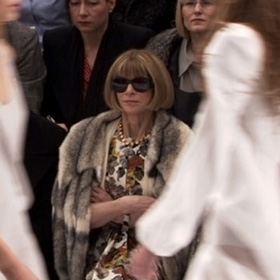The September Issue

3/5
One of the great misconceptions of our time is that reality is somehow story-driven. This is probably the fault of so-called reality television, which would have us believe that the situations that comprise our daily lives are influenced by some larger structure, some sort of overarching plot—after all, this is how it all works on “reality” TV shows like The Hills, My Life as Liz, and any incarnation of The Real Housewives. Expositions lead to conflicts, conflicts to climaxes, climaxes to resolutions, and all in a convenient allotment of time. We move through our days as though we are going from episode to episode of a television program in which we star. The line between what constitutes reality and what constitutes entertainment has been blurred.
So where does one turn for a dose of actual reality? Well, documentary films are a good place to start. Unless you choose to start with The September Issue. Now, to be clear, I enjoyed this film from start to finish: everything about it is lush, spectacular, transporting, and characteristic of a realm that few people will ever experience. But I hesitate to classify all of it as a depiction of what really and truly goes on at Vogue during the rush to create the magazine’s most important issue of the year. Instead, R.J. Cutler’s film hovers somewhere between documentary and the sort of scripted, manipulated reality that we see on Bravo or MTV. The result is a fascinating but somewhat off-balance look at the fashion industry undressed.
I think that by now, most people who are familiar with Vogue (or possibly just The Devil Wears Prada) are also familiar with its famous Editor-in-chief, Anna Wintour. If you don’t know her for her blonde bob and impeccable clothing, then you probably at least know her by her reputation, that is to say icy, ruthless, emotionless, and unforgiving. She is intensely private, and has only recently begun speaking more to the press, seemingly making an effort to dispel the rumors that swirl around her. This was undoubtedly one of the motivating factors behind the film: not only does The September Issue draw attention to a behemoth of print media in an era when print media is facing trouble, it also draws attention to print media’s most well-known and mysterious personalities, giving her a chance to throw her own version of herself into the ring of personae that others have already imposed on her. Unfortunately, this effort comes off as slightly transparent. Throughout the 90-minute film, Wintour is shown making cutting comments to her employees, interacting somewhat distantly with her daughter, and being generally depicted as both isolated and isolating. Yes, her scathing remarks are always delivered with a half-smile, as though to soften the blow, but this does little to suggest that Wintour isn’t, even in her own version of herself, cast as the villain.
Nowhere is this more obvious than in the dynamic set up between Wintour and Vogue creative director Grace Coddington. From the beginning, Wintour and Coddington come off as polar opposites. For example, Wintour’s carefully groomed appearance contrasts sharply with Coddington’s laid-back style and wild red hair, and Wintour is reserved while Coddington is warm and frequently laughing. Through Coddington and Wintour, Good and Evil are very clearly established, and with those two central roles filled, the story can start. The September Issue, then, becomes less a look inside Vogue Biggest Issue Ever, and more a creation of a dual between Business and Art. Wintour and Coddington are both geniuses at what they do, but obviously only one can win in the end.
For roughly 80 minutes, we witness the two women butting heads: Coddington does a fashion shoot, Wintour cuts half of it (and always the parts that Coddington likes most) from the magazine. Our sympathy goes to Coddington, who is infinitely more likeable than her counterpart. In the end, though, Wintour reveals how she really feels about the Creative Director, calling her a genius and saying that no one can do what Grace does. If the conflict between the two women didn’t strike you as somewhat manufactured before this point, it certainly should by this time. It seems that Cutler may have tried a little too hard to create intrigue where it didn’t necessarily exist.
This was further reinforced by the deleted scenes, which, though they jump around and don’t form a coherent whole (they are deleted scenes afterall), had much more of a documentary feel. It is in these scenes that we start to see the person who I think is probably the real Anna Wintour—as she goes from one designer and fashion industry event to the next, we see a woman who has a keen and awe-inspiring business sense, an affectionate relationship with her daughter, and a sense of humor. She is open, relaxed, and supportive of the designers she meets. None of this is really evident in the film itself, which is edited heavily enough that Wintour comes off as an almost entirely different person. The amount of deleted material included on the two discs is enough to make up a second movie, one that would be far more realistic and, I believe, interesting than the one that was released in theaters.
DVD Special Features:
Disc 1: Audio commentary from director R.J. Cutler; Deleted Scenes; Behind-the-scenes photos taken by Bob Richman; Theatrical Trailer. Disc 2: Additional deleted scenes.
Director: R.J. Cutler
Distributor: Lions Gate
Runtime: 90 minutes
Rated: PG-13
RELATED ARTICLES
Get the most-revealing celebrity conversations with the uInterview podcast!







Leave a comment